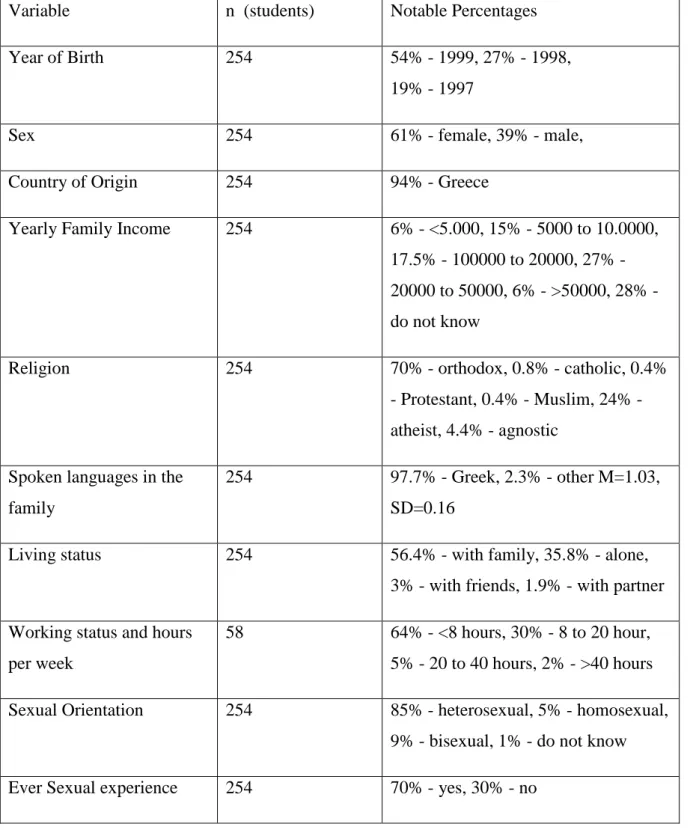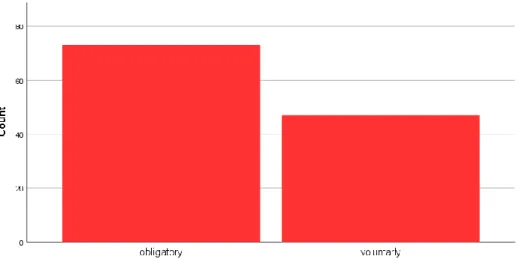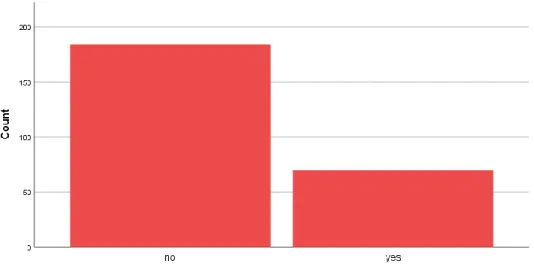The provision of sexuality education as part of the formal education system varies between countries; however, the existing bibliography suggests that wherever it exists, it has significant positive outcomes in how young people manage their bodies, build healthy interpersonal relationships, and explore their sexuality. It was a sunny afternoon in the picturesque area of Plaka in Athens when we first sat down to discuss the possibility of presenting the dissertation as a collaborative effort and maybe, just maybe, producing a decent publication out of the process. The former, a metropolis of almost 4 million people located in the heart of Europe, has usually been described as the center of the continent, both geographically and ethnographically.
11 We decided to create a qualitative study that would present a comparative analysis between the students of the two capitals – both cities have a vibrant city life, with numerous universities spread across their grounds. We declare that no fraud was attempted and this is simply due to the similarities in both subjects and because we worked as a team for most of the process.
Introduction and background of the study
On the other hand, combining these programs with the structured provision of sex education classes produces much better results. Asia is a good example of the previous statement, offering great wide variations between its countries when it comes to the application of sex education tactics. In Africa, due to a lack of official sex education by the state, the efforts of non-governmental organizations and private parties in the field are impressive.
According to the authors, this is another link in the chain of progressive fading of the official sex education in the USA. Australia, with an education system often praised as one of the best in the world, offers widely accessible safe and effective family planning and sexuality education programs.
Relevant Information
Structured sex education leads to safe sexual practices and can prevent unwanted pregnancies and sexually transmitted infections. In the US, evaluation of early 21st century educational programs within the school system has shown that they produce significant results in reducing unwanted pregnancies and sexually transmitted infections, including HIV. Several governmental and non-governmental organizations have pointed out the need for a structured sex education course in the Greek education system.
Although relevant information is very scarce, we will try to provide a synopsis of some of the programs that have been developed in recent years in Greece. It is made clear that the implementation of sex education classes in the Greek high school has ranged from slow to totally non-existent.
Aim and Objectives of present and joint study
Methodology
26 brief description of our survey objectives, followed by demographics that allowed us to weight our samples ideally. The development of the questionnaire was initially done in English, following the back-to-back translation method into Greek (by a bilingual Greek-English native speaker). A pilot study was conducted on students who had the same characteristics as our sample but studied in the city of Patras, Greece.
Sampling began in early January 2018 and the process of collecting the required responses took approximately 3 months. Initially, our target group was very eager to fill out the questionnaire, followed by short periods of inertia, which we tried to overcome by promoting our study through social media and electronic communication. The questionnaire was available online for a period of three months (January to March 2018) and after deactivating the links, 254 valid responses from Athens were available for analysis.
A pilot study to determine the accuracy and accountability of the questionnaire was conducted among first-year students from higher education institutions in Patras, Greece. The questionnaire was distributed online through Facebook pages and university forums and had been online for 3 days. The data from the online questionnaires were collected, arranged in the right form and transferred to the statistical analysis program "IBM - SPSS Statistics".
The main limitation of our study is the sensitivity of the topic we want to investigate. Moreover, we consider it more reliable if the questionnaire is completed without our presence, because this can distort the answers and results. The sensitivity of the matter coupled with its accessibility to a large population of people not in tertiary education prevented us from including them in the study.
Results and Future Prospects
Most students would have preferred to have received such information from an official source such as sex education experts (60%) or schools (35%). When asked if they had received sex education from an official source, 53% of the sample said 'no' (Fig. 3). 78% of students believe that more hours are needed for such a program, if it is to be developed.
The majority of participants did not use any form of contraception at their first intercourse (Fig. 6). 35 Table 3: Statistical results and significance of the variables testing the participants' sexual status (active/inactive) - analyzed using SPSS. Interpreting our results, the majority of participants used some form of contraception at their first sexual encounter regardless of their gender.
Interpreting our results, most participants • used some form of contraception at their first sexual encounter, regardless of sex. A chi-square test was conducted to examine students' knowledge of STD herpes. A chi-square test was performed to examine students' knowledge of HPV.
A chi-square test was conducted to examine students' knowledge of the STD trichomonas vaginalis. The majority of sexually active students have not attended any formal course, while the majority of sexually inactive students have participated in such a program (X2 (1, N p = 0.037). More specifically, the majority of sexually inactive students agree with the statement; most sexually active students disagreed and there was no significant difference between groups reporting no response (post hoc analysis with Bonferroni correction).

Comparative study between Athens and Berlin
Specifically, in Berlin most students reported receiving sexuality education from a formal source, while in Athens most students did not receive formal sexuality education. A chi-square test was performed and a significant interaction was found between the country of origin and the number of hours attending the educational program. A chi-square test was conducted to test students' knowledge of sexually transmitted diseases HIV/AIDS in both countries; statistical analyzes showed that the majority of students.
A chi-square test was conducted to examine students' knowledge of the STD Chlamydia in the two countries; Statistical analysis showed that among those who were aware of the disease, most studied in Greece, while among those who were unaware, most were studied in Germany (X2 (1, N p = 0.003). A chi-square test was conducted to assess students' knowledge about the STD Gonorrhea in the two countries; statistical analysis showed that most students were aware of the disease regardless of the country where they study (X2 (1, N p = 0.146 ) A chi-square test was conducted to examine students' knowledge about STD Herpes in the two countries; statistical analysis showed that most students were aware of the disease regardless of the country where they study (X2(1, N p = 0.184).
A chi-square test was conducted to examine students' knowledge of STD HPV in the two countries; statistical analysis revealed that among those who were aware of the disease, most were surveyed in Greece, whereas among those who were unaware, most were surveyed in Germany (X2 (1, N p < 0.001). A chi-square test was conducted to investigate the knowledge of students regarding the STD Trichomonas in the two countries; statistical analysis revealed that among those who studied in Greece, most participants were aware of the disease, whereas most of those who studied in Germany were unaware (X2 (1, N p < 0.001). A chi-square test was conducted to examine students' knowledge of the STD Syphilis in the two countries; statistical analysis revealed that among those who were aware of the disease, most studied in Greece, whereas among those who were unaware, most studied in Germany (X2 (1, N p = 0.021).
A chi-square test was conducted to examine students' knowledge of the venereal disease hepatitis in the two countries; statistical analysis showed that in both countries most students were aware of the disease; however, the proportion of aware students was much greater in Germany, and this difference was statistically significant (X2 (1, N p < 0.001). In Berlin, the majority of students have participated in such a program, and in most cases it has been compulsory and from an official source.More specifically, students from both cities seem to be more or less aware of sexually transmitted diseases, however, what is notable is that people studying in Greece appear more knowledgeable about many of the venereal diseases included in the study.
BIBLIOGRAPHY
The effects of sex education on promoting sexual and reproductive health among Portuguese university students. Contraceptive use, knowledge, attitudes, perceptions and sexual behavior among female university students in Uganda: a cross-sectional study. Sexual activity and contraceptive use among young female students of tertiary educational institutions in Ilorin, Nigeria.
HIV sexual risk behaviors and risk perception among college students: implications for intervention planning. State of the Union: Sexual health disparities in a national sample of US college students. Sex education in schools should be banned, says Union health minister Harsh Vardhan - Times of India [Internet].
Teenage dating violence (physical and sexual) among US high school students: Findings from the 2013 National Youth Risk Behavior Survey. Group-based comprehensive risk reduction and abstinence education interventions to prevent or reduce the risk of adolescent pregnancy, human immunodeficiency virus, and sexual. Abstinence only and comprehensive sex education and initiation of sexual activity and teenage pregnancy.
Science and Success: Sex Education and Other Programs to Prevent Teen Pregnancy, HIV, and Sexually Transmitted Infections.
APPENDICES
Extended Greek Abstract
Questionnaire used for present study





